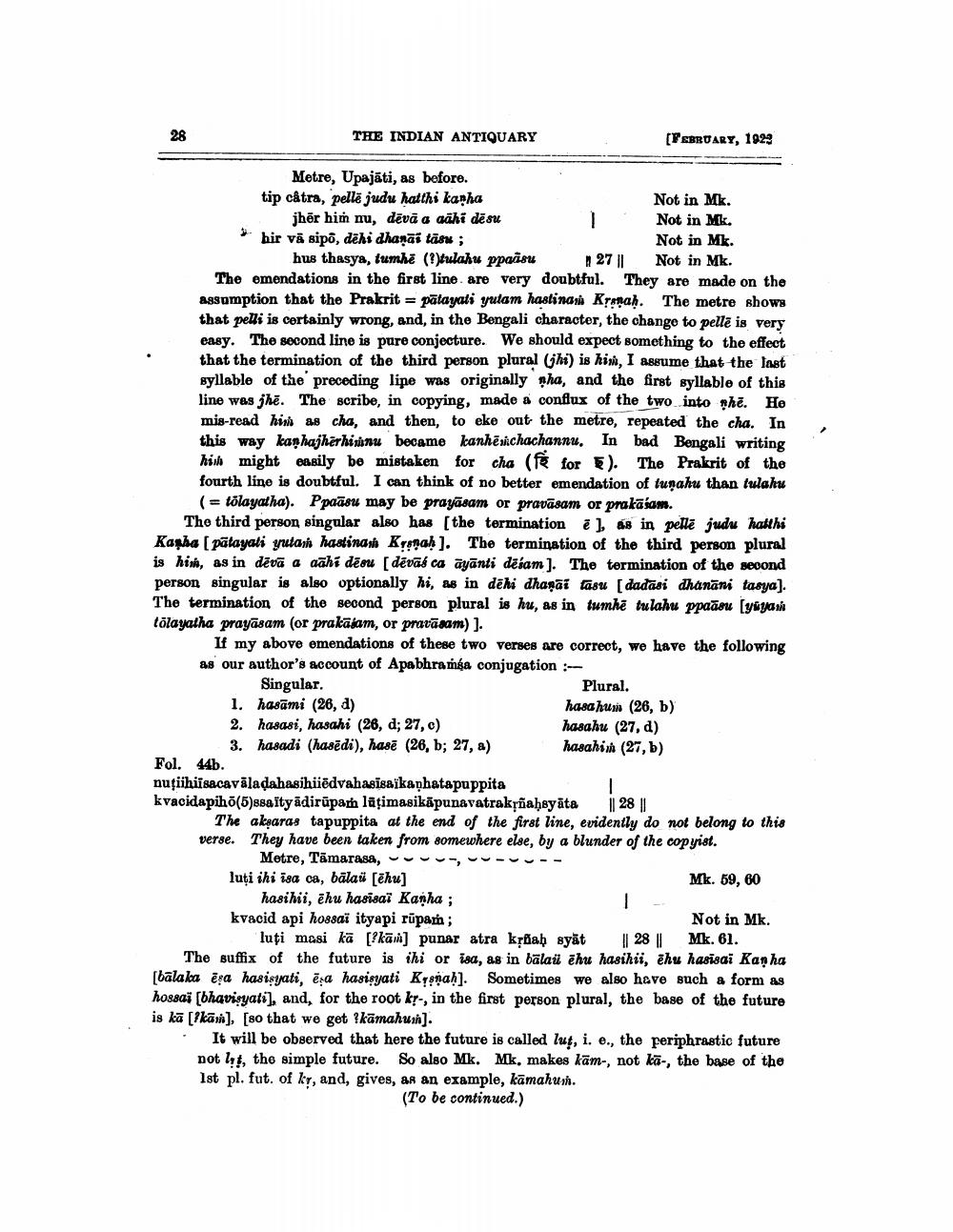________________
THE INDIAN ANTIQUARY
(PSBRUARY, 1922
Metre, Upajāti, as before. tip c&tra, pellë judu hatthi kanha
Not in Mk. jhēr him nu, dēvă a gähi dēsu
Not in Mk. hir va sipo, dēhi dhanai tāsu;
Not in Mk. hus thasya, tumhë (?)tulahu pparisu 27 || Not in Mk. The emendations in the first line are very doubtful. They are made on the assumption that the Prakrit = pātayati yulam hastinasi Kranah. The metre shows that pelli is certainly wrong, and, in the Bengali character, the change to pellē is very easy. The second line is pure conjecture. We should expect something to the effect that the termination of the third person plural Ghi) is him, I assume that the last syllable of the preceding lipe was originally nha, and the first syllable of this line was shē. The scribe, in copying, made a conflux of the two into whë. Ho mis-read him as cha, and then, to eke out the metre, repeated the cha. In this way kanhajhêrhininu became kanhēschachannu. In bad Bengali writing himb might easily be mistaken for cha ( for ). The Prakrit of the fourth line is doubtful. I can think of no better emendation of tunahu than tulaku
( = tõlayatha). Ppaāsu may be prayāsam or pravāsam or prakasam.
The third person singular also has [the termination é ), as in pelle judu hakthi Kapha ( pātayali yulan hastinasi Krsnah). The termination of the third person plural is him, as in dēva a aāhi dēsu [ devās ca āyānti dēíam). The termination of the second person singular is also optionally hi, as in dēhi dhaņai tasu [dadāsi dhanāni tasya]. The termination of the second person plural is hu, as in tumhe tulahu ppaāsu (yuyash tölayatha prayasam (or prakasam, or pravā sam) ).
If my above emendations of these two verses are correct, we have the following as our author's account of Apabhramsa conjugation -- Singular.
Plural. 1. hasāmi (26, d)
hasa huu (26, b) 2. hasasi, hasahi (26, d; 27, c)
hasahu (27, d) 3. hasadi (hasēdi), hasē (26, b; 27, a) hasahin (27, b) Fol. 44b. nuţiihiisacavāladahasihijēdvahasiskikaphatapuppita kvacidapihõ(5)ssaityadirüpar laţimasikäpunavatrakļñahayāta || 28 ||
The aksaras tapuppita at the end of the first line, evidently do not belong to this verse. They have been taken from somewhere else, by a blunder of the copyist. Metre, Tāmarasa, v
vluţi ihi isa ca, bālai [ēhu]
Mk. 59, 60 hasihii, ēhu hasisai Kanha ; kvacid api hossai ityapi rupan;
Not in Mk. luți masi kā [ikān] punar atra krah syät | 28 Mk. 61. The suffix of the future is ihi or isa, as in bälail Zhu hasihii, ehu hasisai Kanha balaka ēga hasistati, ēra hasisyati Kysnah). Sometimes we also have such a form as hossai (bhavisyati), and, for the root kr-, in the first person plural, the base of the future is kā [1kāvi), [so that we get Ikämahusn).
It will be observed that here the future is called lug, i. e., the periphrastic future not hat, the simple future. So also Mk. Mk, makes käm-, not ka-, the base of the 1st pl. fut. of ky, and, gives, as an example, kamahun.
(To be continued.)
oito




